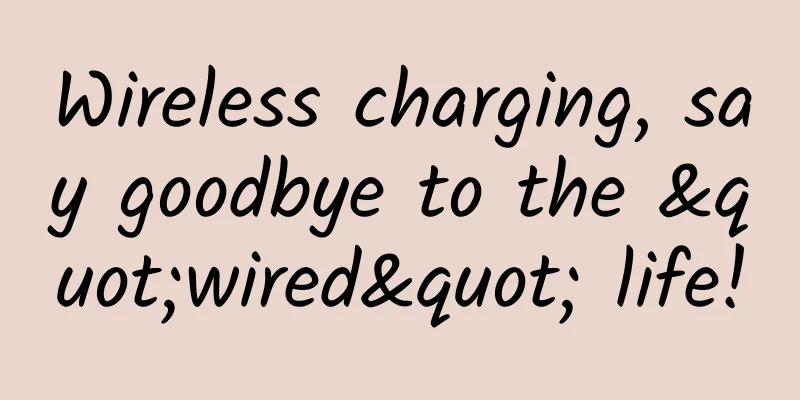Wireless charging, say goodbye to the "wired" life!

|
Wireless charging form There are three types of wireless charging, namely electromagnetic induction, magnetic field resonance and radio wave. The most common wireless charging method is electromagnetic induction represented by Qi wireless charging. If there is a Qi logo on an electronic product, it means that it can be charged wirelessly. The magnetic charging of the second generation of Apple Pencel and the reverse charging of Huawei Matepad Pro all use Qi wireless charging technology. Let me tell you a secret: China's BYD company applied for a patent for a contactless inductive charger using electromagnetic induction technology as early as December 2005. How much do you know about charging principles ? Electromagnetic induction Due to the magnetic effect of electric current, a magnetic field is generated around the current-carrying wire. If the wire is wound into a spiral coil as shown in the figure, the direction of the magnetic field will change from surrounding the wire to radially passing through the wire. Such spiral coils are placed in the charging base and the electrical appliance. The alternating current generates a changing magnetic field through the power transmission coil of the charging base. When the electrical appliance is placed on the charging base, the changing magnetic field passes through the power receiving coil in the electrical appliance, thereby generating current, transferring energy from the transmitting end to the receiving end, and the battery begins to charge. Magnetic field resonance The energy transmitter and receiver of the resonator are composed of a small capacitor connected in parallel or in series with a large inductor coil. When the two are adjusted to the same frequency, magnetic resonance will occur [1], and energy will be exchanged between them. This is a technology currently under research. The research team led by Marin Soljacic, a physics professor at the Massachusetts Institute of Technology (MIT), used this technology to light up a 60-watt light bulb two meters away and named it WiTricity. However, the diameter of the coil used in the experiment reached 50 cm. If the coil size is reduced, the receiving power will decrease, so it has not yet been commercialized. Radio wave The principle is to convert ambient electromagnetic waves into electric current and transmit the electric current through the circuit. This wireless charging method has a transmission distance of more than 10 meters, which is suitable for long-distance low-power charging, and can also realize automatic charging anytime and anywhere. However, due to the low conversion efficiency, if this method is used, the charging time will be relatively long. Keep pace with the times: The wireless charging innovation team of the Digital Institute of the Shenzhen Institute of Advanced Technology of the Chinese Academy of Sciences has also conducted research on the technical development and product customization of magnetic resonance wireless charging low-power application scenarios. At present, the team has completed the research and development of key technologies and equipment for magnetic field resonance coupling and produced a prototype of a wireless charging system. Simply by bringing an object close to the magnetic resonance coil, "wireless charging" can be achieved. Simulation diagram of multiple devices charging at the same time Compared with electromagnetic induction, magnetic resonance wireless charging can achieve long-distance (ranging from a few centimeters to a few meters) and efficient (some transmission efficiency reaches more than 80%) power supply, and even one-to-many power supply. Without further ado, let's summarize: The way to charge a shared electric vehicle is to manually replace the battery. You can know the remaining power of any nearby vehicle and the remaining mileage on the APP interface. The difference between shared electric vehicles and shared bicycles is that they must be parked at a "fixed point". The parking place is fixed and planned. Most communities and shopping malls and supermarkets have parking spots. The editor has something to say: Image source: Pixabay If wireless charging technology can be widely used, perhaps the power supply problems of medical devices implanted in the body such as pacemakers, sensors, defibrillators, etc. can be effectively solved. Contributors: Southwest University Popular Science Space Station, Chongqing Physics Society, Beibei District Science and Technology Association Audit expert: Zhang Qiaoming Statement: Except for original content and special notes, some pictures are from the Internet. They are not for commercial purposes and are only used as popular science materials. The copyright belongs to the original authors. If there is any infringement, please contact us to delete them. |
>>: If we cut off the free live broadcasts, do we still need a TV in the living room?
Recommend
What are the techniques for search bidding mobile promotion? Here are 8 suggestions for you
What are the techniques for search bidding mobile...
What changes will happen to the body 72 hours after death? (Don't be afraid, please read it with confidence)
This article was reviewed by Zhang Yinming, PhD i...
A brief discussion on APP promotion and operation: How to place advertisements accurately?
Preface As of the end of March this year, accordi...
The 10 most popular growth hacking strategies in 2018!
We feel it’s necessary to share with you our rese...
White skin, beautiful face and long legs! The black-winged stilt has the supermodel temperament...
In March, when spring is warm and flowers are blo...
World Alzheimer's Day丨Keep the "eraser of memory" away from us
September 21, 2022 The 29th World Alzheimer's...
Information on returning home policies in 31 provinces and cities: one-stop query on Alipay
Recently, the General Office of the CPC Central C...
Zero-based flat texture style commercial illustration tutorial
Zero-based flat texture style commercial illustra...
Chu Shijian's resume: Which aspects should we focus on when optimizing website structure?
The website structure has been optimized to make ...
For more than 3,000 days and nights, he turned the "beam of dreams" into the "light of reality"
Author: Zhang Shuanghu At 3 a.m. on January 11, 2...
Family! Microwave ovens can really cook, and they are healthier than boiling water
Nowadays, various popular small household applian...
The auto market continued to be sluggish in August. These factors may lead to negative growth in the auto market throughout the year.
Data released by the China Passenger Car Associat...
Liu Yao video collection (17 sets 138.39G)
Liu Yao video collection (17 sets 138.39G) Resour...
up to date! Data rankings of 59 advertising platforms!
Let’s take a detailed look at the data performanc...
How to apply for WeChat Video Account? Video account application process and rules!
Affected by the epidemic, enterprises in all indu...









